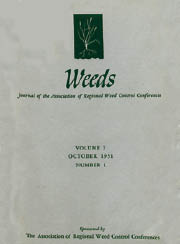Crossref Citations
This article has been cited by the following publications. This list is generated based on data provided by
Crossref.
Anderson, W. Powell
Richards, Anna Beth
and
Whitworth, J. Wayne
1968.
Leaching of Trifluralin, Benefin, and Nitralin in Soil Columns.
Weed Science,
Vol. 16,
Issue. 2,
p.
165.
Arle, H. Fred
1968.
Trifluralin—Systemic Insecticide Interactions on Seedling Cotton.
Weed Science,
Vol. 16,
Issue. 4,
p.
430.
Lund, Zane F.
Pearson, R. W.
and
Buchanan, Gale A.
1970.
An Implanted Soil Mass Technique to Study Herbicide Effects on Root Growth.
Weed Science,
Vol. 18,
Issue. 2,
p.
279.
Rahman, A.
and
Ashford, R.
1970.
Selective Action of Trifluralin for Control of Green Foxtail in Wheat.
Weed Science,
Vol. 18,
Issue. 6,
p.
754.
Schweizer, E. E.
1970.
Aberrations in Sugarbeet Roots as Induced by Trifluralin.
Weed Science,
Vol. 18,
Issue. 1,
p.
131.
Norton, J. A.
Walter, J. P.
and
Storey, J. B.
1970.
The Effect of Herbicides on Lateral Roots and Nut Quality of Pecans.
Weed Science,
Vol. 18,
Issue. 4,
p.
520.
Hassawy, Ghanem S.
and
Hamilton, K. C.
1971.
Effects of IAA, Kinetin, and Trifluralin on Cotton Seedlings.
Weed Science,
Vol. 19,
Issue. 3,
p.
265.
Kust, Cyril A.
and
Struckmeyer, B. Esther
1971.
Effects of Trifluralin on Growth, Nodulation, and Anatomy of Soybeans.
Weed Science,
Vol. 19,
Issue. 2,
p.
147.
Strang, R. H.
and
Rogers, R. L.
1971.
A Microradioautographic Study of14C-Trifluralin Absorption.
Weed Science,
Vol. 19,
Issue. 4,
p.
363.
Barrentine, W. L.
and
Warren, G. F.
1971.
Shoot Zone Activity of Trifluralin and Nitralin.
Weed Science,
Vol. 19,
Issue. 1,
p.
37.
Hassawy, Ghanem S.
and
Hamilton, K. C.
1971.
Effects of Trifluralin and Organophosphorus Compounds on Cotton Seedlings.
Weed Science,
Vol. 19,
Issue. 2,
p.
166.
Eshel, Y.
and
Katan, J.
1972.
Effect of Dinitroanilines on Solanaceous Vegetables and Soil Fungi.
Weed Science,
Vol. 20,
Issue. 3,
p.
243.
Frear, D.S.
Hodgson, R.H.
Shimabukuro, R.H.
and
Still, G.G.
1972.
Vol. 24,
Issue. ,
p.
327.
Hawxby, K.
Basler, E.
and
Santelmann, P. W.
1972.
Temperature Effects on Absorption and Translocation of Trifluralin and Methazole in Peanuts.
Weed Science,
Vol. 20,
Issue. 4,
p.
285.
Wilson, H. P.
and
Stewart, F. B.
1973.
Relationship Between Trifluralin and Phosphorus on Transplanted Tomatoes.
Weed Science,
Vol. 21,
Issue. 2,
p.
150.
Ayonoadu, U. W. U.
Norrington-Davies, J.
Edje, O. T.
and
Mughogho, L. K.
1974.
Weed control and its effects on yield ofPhaseolus vulgarisbeans in Malawi.
The Journal of Agricultural Science,
Vol. 82,
Issue. 2,
p.
283.
Arle, H. F.
and
Hamilton, K. C.
1975.
Rates of Herbicides in Irrigated Cotton.
Weed Science,
Vol. 23,
Issue. 3,
p.
179.
Hamilton, K. C.
and
Arle, H. F.
1975.
Preplanting Applications of Diuron With and Without Trifluralin in Cotton.
Weed Science,
Vol. 23,
Issue. 1,
p.
75.
Deuber, Robert
Forster, Reinaldo
and
Signori, Lúcia Helena
1977.
Local de ação de trifluralin na germinação de capim-carrapicho.
Bragantia,
Vol. 36,
Issue. 1,
p.
259.
Parka, S. J.
and
Soper, O. F.
1977.
The Physiology and Mode of Action of the Dinitroaniline Herbicides.
Weed Science,
Vol. 25,
Issue. 1,
p.
79.


